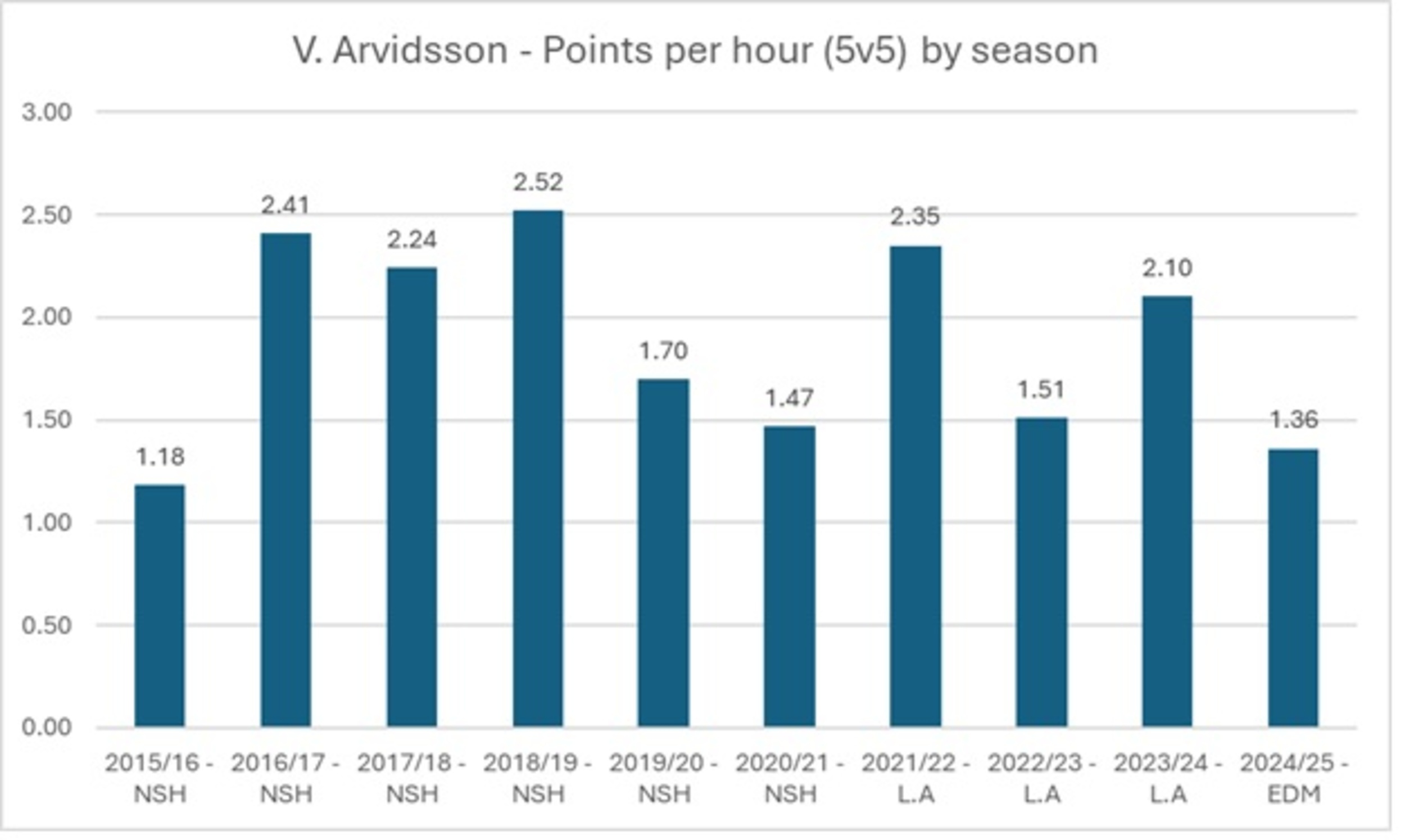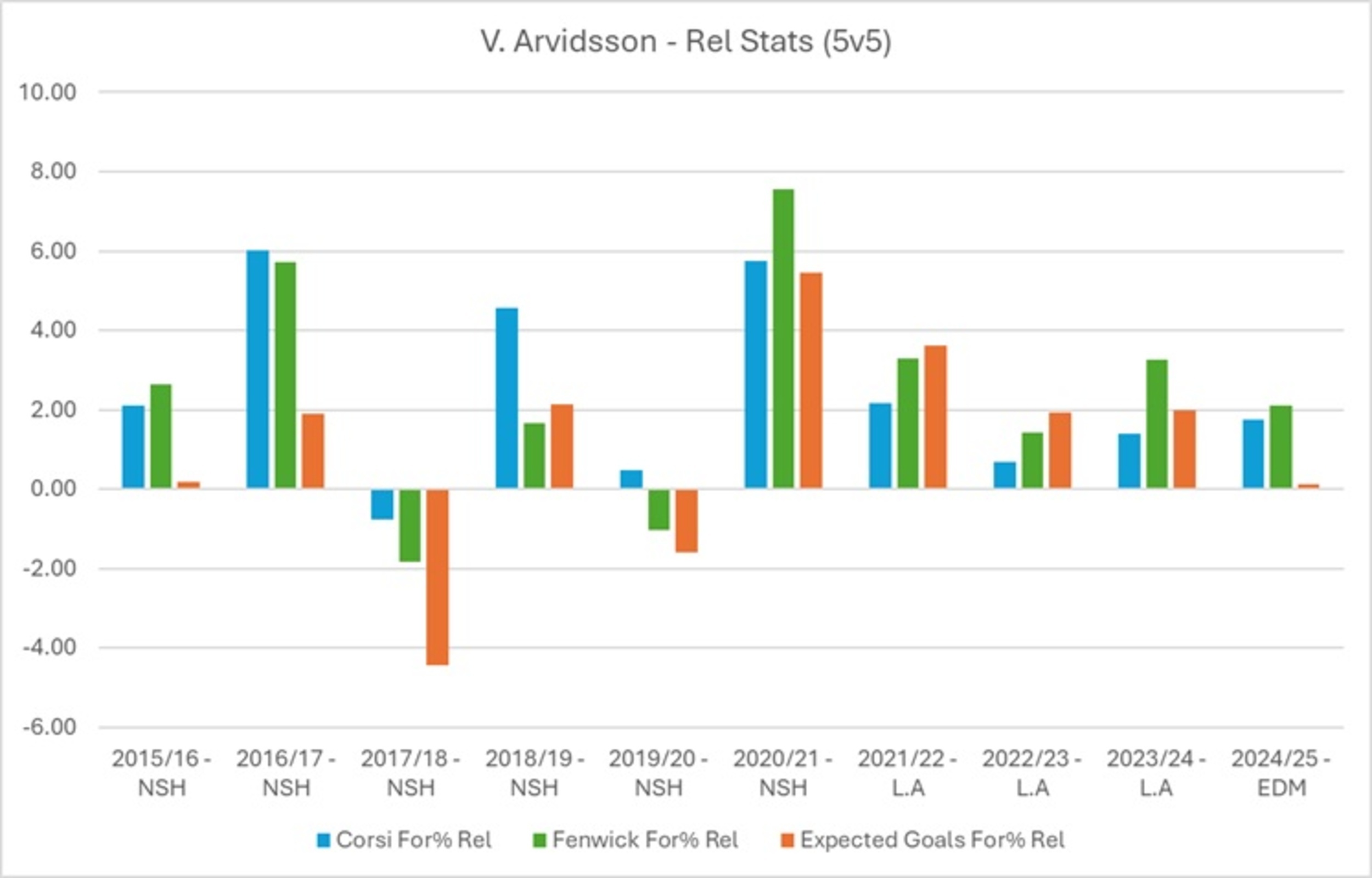
Fair to say that the Edmonton Oilers front office will have a busy off-season. After a solid playoff run that again fell short, it’s imperative that they apply a critical lens, identify inefficiencies across the roster, and address the gaps to stay competitive.
Based on Stan Bowman’s recent media availability, it appears that the Oilers forward group will get the most attention from the front office. There’s likely going to be a push to shed some older players and make room on the regular roster for the few young prospects in the system. And there’s also the need to clear up cap space to sign key players such as Evan Bouchard and allocate dollars to address the goaltending.
One forward that the Oilers are currently looking to move on from is winger Viktor Arvidsson, as he’s in the last year of his two-year contract that pays $4 million this upcoming season. Arvidsson has had a solid career thus far, putting up 389 points in 612 games over eleven seasons. But this past regular season, his numbers slipped slightly as he put up 15 goals and 12 assists in 66 games (in all situations). At even-strength, Arvidsson ranked eighth among the Oilers forwards in terms of points per hour with 1.36. This was his lowest output since his rookie season.

While it does make some sense to reallocate his dollars to address other parts of the roster, it’s important to highlight what the Oilers will lose if/when they trade Arvidsson away.
The first thing that stands out when assessing Arvidsson is the positive impact he tends to have on his team’s ability to control the flow of play and scoring chances. Consistently over his career, his teams tend to do better with him on the ice than without him when it comes to puck possession and expected goals metrics. This past season, for instance, his on-ice Corsi For percentage (55 percent) and Expected Goals For percentage (56 percent) were both fifth best among Oiler forwards behind McDavid, Hyman, Draisaitl and Podkolzin. More on this in a second.
The table below shows Arvidsson’s on-ice shot-differential numbers relative to his teammates. Being above zero means that Arvidsson typically outperformed the team average, which is impressive considering how strong the Oilers’ underlying shot-share numbers were this past season. This trend has continued since his time in Los Angeles, and there doesn’t appear to be a significant drop-off in his performance just yet.

Slotting often into the top-six forward group, Arvidsson also played a chunk of his ice time against elite-level opponents and fared quite well. In 203 minutes at even-strength this season, Arvidsson’s Corsi For percentage against elite players was 57 percent – which ranked third among regular Oiler forwards. His Dangerous Fenwick, which is similar to expected goals, was at 59 percent and also one of the best on the team.
And while Arvidsson did play a lot with Draisaitl (394 minutes) and McDavid (82 minutes) at even-strength and posted great on-ice performance numbers with each of them, he also posted great numbers away from them. In 417 minutes without either of the star players on the ice with him this season, Arvidsson posted an on-ice Corsi For percentage of 53 percent and an Expected Goals For percentage of 51 percent. The actual results were a little lacking (48 percent goal-share, -1 goal differential), but that was also impacted by a lower-than-normal PDO of around 96.
One last thing worth pointing out is Arvidsson’s production in this year’s playoffs. He dressed for only 15 of the 22 games and finished 12th in even-strength ice time among forwards (164 minutes). But he did put up two goals and five assists in these limited minutes, which translates into a rate of 2.55 points per hour. That was the second highest among all Oilers forwards, only behind McDavid.
This isn’t to say Arvidsson is a perfect player — he’s not. But there’s going to be gaps that the Oilers will need to address if/when they move him out. He’s a reliable play driver who can play with and without a team’s best players. He can perform well against top-level competition. And he does have a history of relatively good production. These are things that the Oilers are likely cognizant of and will need to factor in when identifying and/or acquiring their replacement(s).
Teams that are considering acquiring Arvidsson would be getting a solid, experienced NHL winger. One that could help elevate a team’s ability to control the flow of play and increase their odds of outscoring opponents. They’d also be getting Arvidsson in a contract year, which could serve as a motivator for the player to keep his focus and hopefully productivity at the highest level. Arvidsson is also coming off a season where his on-ice PDO was close to 96, indicating that in the right situation, his rate of points could bounce back to his career levels. Definitely a buy-low candidate that could pay dividends for a team in tune with his underlying numbers and the Oilers’ desperation.
Data: Natural Stat Trick, Puck IQ, Puckpedia
More must-reads:
- What's next for Connor McDavid? Four scenarios for Oilers superstar
- Hockey Hall of Fame announces 2025 class
- The 'Most goals in a Stanley Cup Playoffs' quiz
Customize Your Newsletter
 +
+
Get the latest news and rumors, customized to your favorite sports and teams. Emailed daily. Always free!








